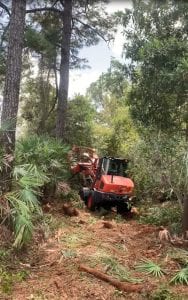Protecting Campus and Community From Wildfire

Fire is a critical component of nearly every ecosystem in the southeastern United States. Central Florida is the lightning capital of the U.S., and historically our frequent thunderstorms ignited fires in the forest. As a result, many of the state’s natural ecosystems would burn every 2-5 years. During periods of extreme dry weather, especially during the transition from the dry season to the wet season in late spring, major natural wildfires occurred. These frequent fires kept the flammable material, or “fuel loads”, low decreasing the severity of the fires. However, due to decades of fire suppression fuel loads have built up to unnatural levels, increasing the potential for catastrophic wildfire. Because of the large number of residents living adjacent to UCF’s forest, the risk of wildfires impacting these urban areas has increased. UCF’s forests are managed in order to mitigate for potentially devastating wildfires; we do this by communicating with stakeholders, planning for hazard mitigation and actively managing lands with mechanical clearing and prescribed fire. One important aspect of protecting properties adjacent to our natural lands is creating a “defensible space” of cleared area between our natural lands and our neighbors.
Last month, UCF’s Land Management Program received assistance from the Florida Forest Service’s (FFS) Wildfire Hazard Mitigation grant program which helps landowners create and maintain areas of defensible space near residential communities. Mechanical treatment (mowing) is a land management technique that reduces heavy wild land fuel loads and mimics the disturbance of fire using heavy equipment, like a bulldozer or tractor. FFS recently completed mulching a 50-foot buffer of defensible space along UCF’s property lines and the adjacent neighborhoods of University Estates, Regency Park and Ginger Creek. This defensible space increases accessibility to our forests for firefighters in the event of a wildfire. We also encourage our neighbors to adopt a “fire wise” mentality when living alongside the natural lands. Case studies have shown the most critical area of “defensible space” occurs within 30 feet of a structure. Residents should maintain a lean, clean and green landscape within 30 feet of their home in order to ensure safety in the event of a wildfire.
The most cost-effective and ecologically beneficial way to reduce dangerous fuel load buildup in Florida’s natural upland ecosystems is through prescribed burning. Using “controlled fire” to reduce the risk of future wildfires may seem counter-intuitive, but Florida’s ecosystems are built to burn under the right weather conditions. UCF’s Prescribed Fire Team conducts controlled burns only under the appropriate weather conditions when it is practical and safe. Regular prescribed burns, along with the forest service’s newly created defensible space mitigation, help to protect UCF and the surrounding community from the risk of wildfires. In addition, these prescribed burns have made our natural lands a showcase of impressive animal and plant biodiversity, managed effectively and safely with fire in the middle of Central Florida’s expanding urban footprint. We are very proud of our Prescribed Fire Program and the benefits it brings to UCF and our neighbors.
